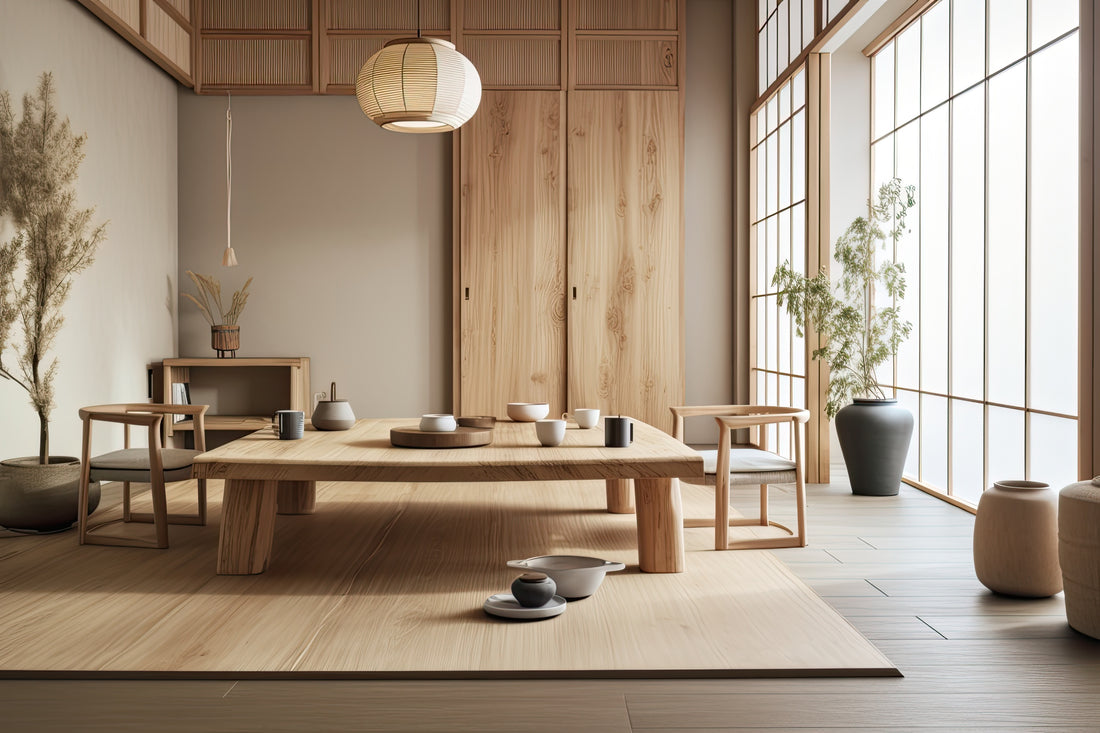
Japanese Inspired Interior Design
Japanese-inspired interior design is a captivating and serene style that brings the essence of Japan into your living space. Whether you’re a fan of minimalism, natural materials, or the concept of wabi-sabi, Japanese interior design offers a unique way to create a tranquil and harmonious environment. In this article, we’ll explore the world of Japanese-inspired interior design, discussing its key principles, elements, and how to incorporate it into your home decor.
Key Principles of Japanese-Inspired Interior Design
Japanese interior design is built on a set of fundamental principles that reflect the culture and traditions of Japan. These principles guide the aesthetics and functionality of the space:
1. Simplicity (Kanso): Simplicity is at the core of Japanese design. It emphasizes uncluttered spaces, minimalistic furniture, and a sense of balance. A simple and clean layout is essential for achieving a tranquil atmosphere.
2. Natural Materials: Japanese design embraces the use of natural materials like wood, bamboo, and paper. These materials not only create an organic and soothing environment but also connect the interior with the natural world.
3. Harmony (Wa): Achieving harmony in Japanese design involves the balance between different elements. It’s about creating a space where everything feels in perfect sync, from furniture placement to color schemes.
4. Functionality (Seikatsu Teki Yoosoo): Furniture and decor in Japanese-inspired design serve a practical purpose. Each piece should be functional and contribute to the overall comfort and usability of the space.
5. Elegance (Shibui): Elegance in Japanese design is achieved through the use of subtle, refined, and unobtrusive elements. It’s about creating an atmosphere that feels both simple and sophisticated.
6. Wabi-Sabi: This unique concept is about embracing imperfection and transience. Wabi-sabi values the beauty found in aging, weathered materials and objects. It’s the appreciation of the imperfect and the acceptance of the transient nature of life.
7. Light and Space: Natural light is an integral part of Japanese interior design. Large windows and open spaces allow the beauty of the outdoors to become an integral part of the interior. Additionally, shoji screens and sliding doors are often used to create flexible spaces and adjust the flow of natural light.
Elements of Japanese-Inspired Interior Design
To create an authentic Japanese-inspired interior, you should incorporate specific design elements:
1. Furniture: Traditional Japanese furniture is often low to the ground, such as chabudai dining tables or zabuton floor cushions. However, modern Japanese design has embraced contemporary furniture with clean lines and minimalistic forms.
2. Tatami Mats: Tatami mats are woven straw mats that cover the floors of traditional Japanese homes. These mats are not only visually appealing but also offer a comfortable, natural flooring option.
3. Shoji Screens: Shoji screens are sliding paper screens used to create versatile and partitioned spaces. They diffuse light beautifully and add an elegant touch to the decor.
4. Fusuma Doors: These are traditional sliding doors often painted with intricate designs. Fusuma doors are used to partition rooms and add a unique artistic element to the space.
5. Tokonoma: A tokonoma is a built-in alcove used for displaying art or a simple arrangement of flowers. It’s a focal point in Japanese interiors, emphasizing the art of space.
6. Zen Gardens: Incorporating a small indoor Zen garden or a bonsai tree can add a touch of tranquility to your space, promoting mindfulness and calm.
Incorporating Japanese-Inspired Interior Design into Your Home
Now, let’s explore how to bring the essence of Japanese design into your home:
1. Simplicity and Minimalism: Start by decluttering your space. Embrace minimalistic furniture and decor to create a sense of simplicity and balance. Keep only what’s essential and ensure that each piece serves a practical purpose.
2. Natural Materials: Introduce natural materials such as wood, bamboo, and stone into your decor. Wooden furniture, bamboo blinds, and stone accents create a connection with nature.
3. Clean Lines and Open Spaces: Incorporate clean lines and open spaces into your design. Create unobstructed pathways and use furniture with straightforward, geometric shapes.
4. Neutral Color Palette: Stick to a neutral color palette that includes whites, beiges, and soft grays. These colors create a serene backdrop for your decor and allow other elements to shine.
5. Paper Screens and Shoji Doors: Consider using shoji screens or sliding doors to create adaptable spaces. These screens let in soft, diffused light, creating a peaceful atmosphere.
6. Low Furniture: If you prefer traditional Japanese aesthetics, opt for low-profile furniture like futons or floor cushions. If modern design is more to your liking, choose minimalist, low-to-the-ground pieces.
7. Wabi-Sabi Accents: Embrace wabi-sabi by incorporating weathered or imperfect elements. You can choose furniture with distressed finishes or display vintage items with a sense of history.
8. Natural Light: Make the most of natural light by maximizing the size of windows and using light, sheer curtains. This enhances the connection between your interior and the outdoors.
9. Indoor Plants: Bring a touch of nature into your home with indoor plants. Bamboo, bonsai, or simple arrangements of fresh flowers can add life and tranquility to your space.
10. Artistic Touches: Create a tokonoma or a designated area for displaying art or a flower arrangement. It serves as a focal point and adds a touch of sophistication to your decor.
Incorporating Japanese-inspired interior design into your home requires thoughtfulness and an appreciation for simplicity and harmony. By following the principles of Japanese design and integrating its key elements, you can create a serene and beautiful living space that reflects the essence of Japan’s rich cultural heritage. Whether you choose to embrace traditional aesthetics or adapt them to a modern style, Japanese design can bring a sense of tranquility and elegance to your home.
Key Principles of Japanese-Inspired Interior Design
Japanese interior design is built on a set of fundamental principles that reflect the culture and traditions of Japan. These principles guide the aesthetics and functionality of the space:
1. Simplicity (Kanso): Simplicity is at the core of Japanese design. It emphasizes uncluttered spaces, minimalistic furniture, and a sense of balance. A simple and clean layout is essential for achieving a tranquil atmosphere.
2. Natural Materials: Japanese design embraces the use of natural materials like wood, bamboo, and paper. These materials not only create an organic and soothing environment but also connect the interior with the natural world.
3. Harmony (Wa): Achieving harmony in Japanese design involves the balance between different elements. It’s about creating a space where everything feels in perfect sync, from furniture placement to color schemes.
4. Functionality (Seikatsu Teki Yoosoo): Furniture and decor in Japanese-inspired design serve a practical purpose. Each piece should be functional and contribute to the overall comfort and usability of the space.
5. Elegance (Shibui): Elegance in Japanese design is achieved through the use of subtle, refined, and unobtrusive elements. It’s about creating an atmosphere that feels both simple and sophisticated.
6. Wabi-Sabi: This unique concept is about embracing imperfection and transience. Wabi-sabi values the beauty found in aging, weathered materials and objects. It’s the appreciation of the imperfect and the acceptance of the transient nature of life.
7. Light and Space: Natural light is an integral part of Japanese interior design. Large windows and open spaces allow the beauty of the outdoors to become an integral part of the interior. Additionally, shoji screens and sliding doors are often used to create flexible spaces and adjust the flow of natural light.
Elements of Japanese-Inspired Interior Design
To create an authentic Japanese-inspired interior, you should incorporate specific design elements:
1. Furniture: Traditional Japanese furniture is often low to the ground, such as chabudai dining tables or zabuton floor cushions. However, modern Japanese design has embraced contemporary furniture with clean lines and minimalistic forms.
2. Tatami Mats: Tatami mats are woven straw mats that cover the floors of traditional Japanese homes. These mats are not only visually appealing but also offer a comfortable, natural flooring option.
3. Shoji Screens: Shoji screens are sliding paper screens used to create versatile and partitioned spaces. They diffuse light beautifully and add an elegant touch to the decor.
4. Fusuma Doors: These are traditional sliding doors often painted with intricate designs. Fusuma doors are used to partition rooms and add a unique artistic element to the space.
5. Tokonoma: A tokonoma is a built-in alcove used for displaying art or a simple arrangement of flowers. It’s a focal point in Japanese interiors, emphasizing the art of space.
6. Zen Gardens: Incorporating a small indoor Zen garden or a bonsai tree can add a touch of tranquility to your space, promoting mindfulness and calm.
Incorporating Japanese-Inspired Interior Design into Your Home
Now, let’s explore how to bring the essence of Japanese design into your home:
1. Simplicity and Minimalism: Start by decluttering your space. Embrace minimalistic furniture and decor to create a sense of simplicity and balance. Keep only what’s essential and ensure that each piece serves a practical purpose.
2. Natural Materials: Introduce natural materials such as wood, bamboo, and stone into your decor. Wooden furniture, bamboo blinds, and stone accents create a connection with nature.
3. Clean Lines and Open Spaces: Incorporate clean lines and open spaces into your design. Create unobstructed pathways and use furniture with straightforward, geometric shapes.
4. Neutral Color Palette: Stick to a neutral color palette that includes whites, beiges, and soft grays. These colors create a serene backdrop for your decor and allow other elements to shine.
5. Paper Screens and Shoji Doors: Consider using shoji screens or sliding doors to create adaptable spaces. These screens let in soft, diffused light, creating a peaceful atmosphere.
6. Low Furniture: If you prefer traditional Japanese aesthetics, opt for low-profile furniture like futons or floor cushions. If modern design is more to your liking, choose minimalist, low-to-the-ground pieces.
7. Wabi-Sabi Accents: Embrace wabi-sabi by incorporating weathered or imperfect elements. You can choose furniture with distressed finishes or display vintage items with a sense of history.
8. Natural Light: Make the most of natural light by maximizing the size of windows and using light, sheer curtains. This enhances the connection between your interior and the outdoors.
9. Indoor Plants: Bring a touch of nature into your home with indoor plants. Bamboo, bonsai, or simple arrangements of fresh flowers can add life and tranquility to your space.
10. Artistic Touches: Create a tokonoma or a designated area for displaying art or a flower arrangement. It serves as a focal point and adds a touch of sophistication to your decor.
Incorporating Japanese-inspired interior design into your home requires thoughtfulness and an appreciation for simplicity and harmony. By following the principles of Japanese design and integrating its key elements, you can create a serene and beautiful living space that reflects the essence of Japan’s rich cultural heritage. Whether you choose to embrace traditional aesthetics or adapt them to a modern style, Japanese design can bring a sense of tranquility and elegance to your home.
